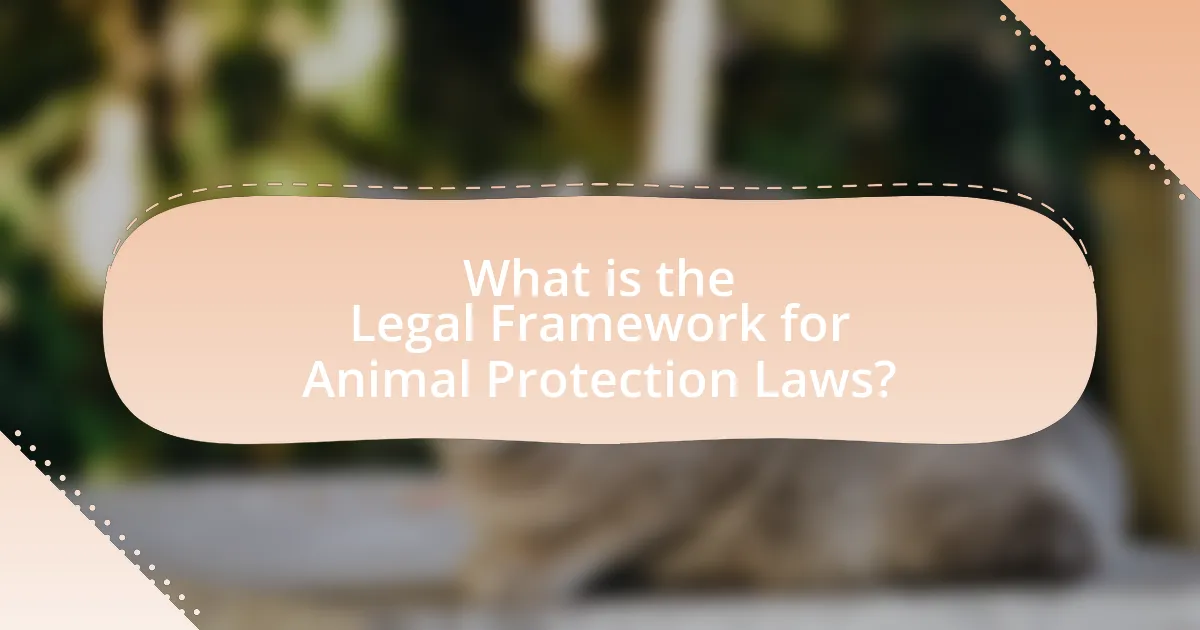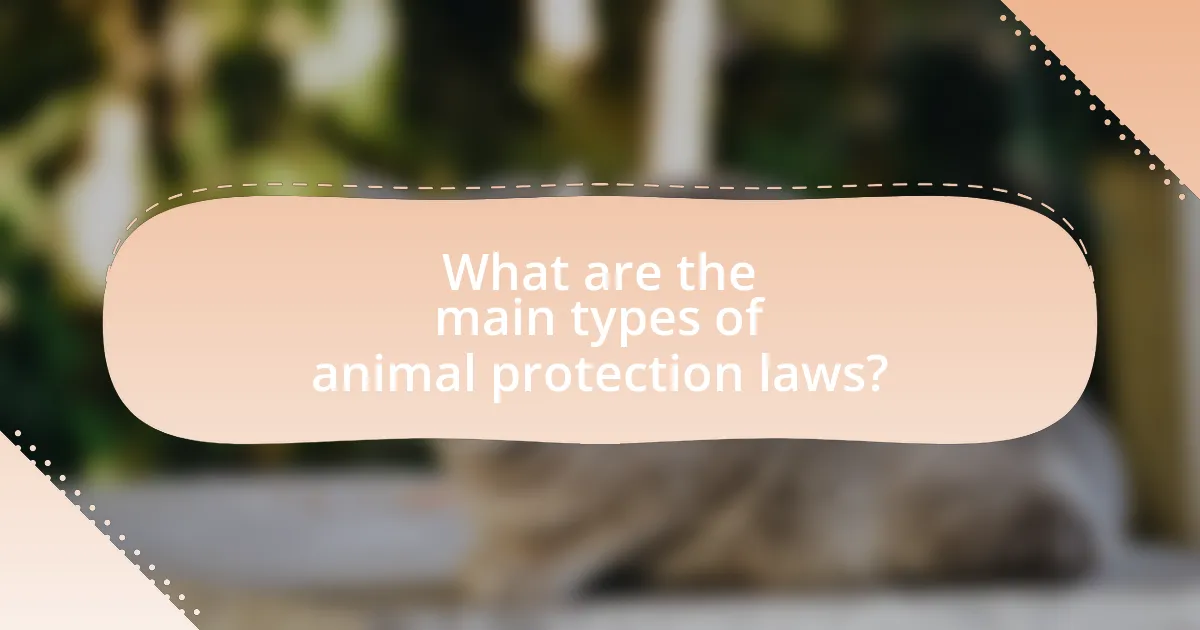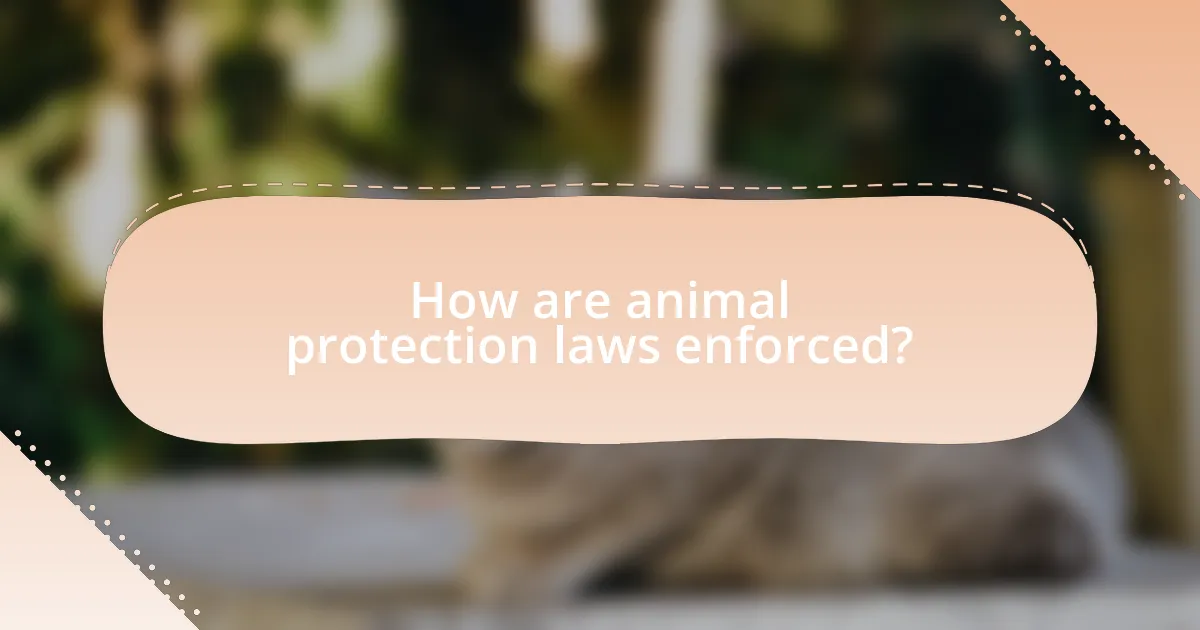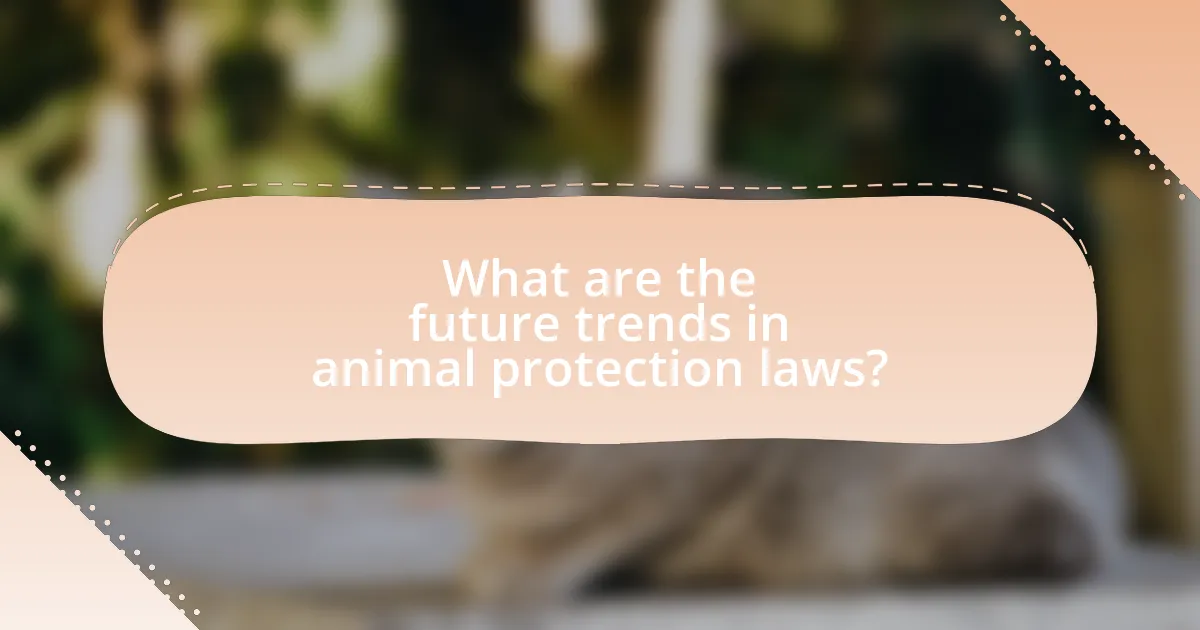The article focuses on the legal framework for animal protection laws, detailing the combination of federal, state, and local statutes aimed at preventing cruelty and ensuring animal welfare. It highlights the Animal Welfare Act as the primary federal legislation in the United States, while also discussing the variations in animal protection laws across different jurisdictions, including specific laws for domestic animals and wildlife. Key components of these laws, the influence of cultural attitudes, and the ethical considerations behind them are examined, along with the enforcement mechanisms and challenges faced in implementing these laws. The article concludes by exploring future trends in animal protection legislation and the role of public opinion and technological advancements in shaping these laws.

What is the Legal Framework for Animal Protection Laws?
The legal framework for animal protection laws consists of a combination of federal, state, and local statutes designed to prevent cruelty and ensure the welfare of animals. In the United States, the Animal Welfare Act (AWA) serves as the primary federal legislation, establishing standards for the treatment of animals in research, exhibition, transport, and by dealers. Additionally, many states have their own animal cruelty laws that vary in scope and enforcement, often providing further protections beyond the AWA. For example, some states have enacted laws addressing specific issues such as puppy mills, animal fighting, and the treatment of farm animals. The effectiveness of these laws is supported by various organizations that monitor compliance and advocate for stronger protections, highlighting the ongoing need for legal reforms to address emerging animal welfare concerns.
How do animal protection laws vary across different jurisdictions?
Animal protection laws vary significantly across different jurisdictions, reflecting diverse cultural values, legal frameworks, and enforcement mechanisms. For instance, in the United States, animal welfare laws are primarily state-based, leading to a patchwork of regulations; some states have stringent laws against animal cruelty, while others have minimal protections. In contrast, countries like Germany have comprehensive animal protection laws enshrined in their constitution, mandating the protection of animals and promoting their welfare. Additionally, the European Union has established regulations that set minimum standards for animal welfare across member states, which further illustrates the variation in legal approaches. These differences highlight how local legal traditions and societal attitudes shape the effectiveness and scope of animal protection laws.
What are the key components of animal protection laws in various countries?
Key components of animal protection laws in various countries include definitions of animal welfare, prohibitions against cruelty, regulations on animal testing, and guidelines for the treatment of farm and companion animals. For instance, the Animal Welfare Act in the United States establishes standards for the humane treatment of animals in research, exhibition, and transport. In the European Union, the Treaty on the Functioning of the European Union recognizes animals as sentient beings, leading to comprehensive regulations on animal welfare across member states. Additionally, countries like Germany have specific laws that mandate the protection of animals in various contexts, including agriculture and entertainment, reflecting a broader commitment to animal rights. These laws often incorporate penalties for violations, ensuring enforcement and compliance.
How do cultural attitudes influence animal protection legislation?
Cultural attitudes significantly influence animal protection legislation by shaping public perception and policy priorities regarding animal welfare. For instance, societies that view animals primarily as companions tend to enact stricter laws against cruelty and neglect, as seen in countries like the United States, where the Animal Welfare Act reflects a strong cultural emphasis on pet protection. Conversely, cultures that prioritize agricultural practices may have more lenient regulations, as evidenced by the European Union’s Common Agricultural Policy, which balances animal welfare with farming interests. These cultural perspectives directly impact legislative outcomes, demonstrating that the values and beliefs of a society play a crucial role in determining the extent and nature of animal protection laws.
Why is a legal framework necessary for animal protection?
A legal framework is necessary for animal protection to establish clear standards and enforceable rights for animals. This framework provides guidelines that define acceptable treatment, prohibits cruelty, and outlines penalties for violations, ensuring accountability. For instance, the Animal Welfare Act in the United States sets minimum standards for the care and treatment of animals in research, exhibition, and transport, demonstrating how legislation can protect animal welfare. Without such laws, there would be no formal recourse for addressing abuse or neglect, leaving animals vulnerable to mistreatment.
What are the ethical considerations behind animal protection laws?
Animal protection laws are grounded in ethical considerations that prioritize the welfare and rights of animals. These laws reflect the moral obligation to prevent suffering and ensure humane treatment, recognizing that animals are sentient beings capable of experiencing pain and distress. Ethical frameworks, such as utilitarianism and rights-based theories, support the idea that animals deserve protection from exploitation and harm, similar to human rights. For instance, the Animal Welfare Act in the United States establishes standards for the care and treatment of animals in research, exhibition, and transport, highlighting the ethical commitment to minimize suffering. Additionally, public sentiment increasingly favors animal rights, influencing legislation and reinforcing the ethical imperative to protect animals from cruelty and neglect.
How do these laws impact animal welfare and rights?
Animal protection laws significantly enhance animal welfare and rights by establishing legal standards that prevent cruelty and promote humane treatment. These laws create a framework that holds individuals and organizations accountable for the treatment of animals, thereby reducing instances of abuse and neglect. For example, the Animal Welfare Act in the United States sets minimum care standards for animals in research, exhibition, and transport, which directly influences the conditions in which these animals live. Studies have shown that regions with stricter animal protection laws report lower rates of animal cruelty incidents, indicating a direct correlation between legal frameworks and improved animal welfare outcomes.

What are the main types of animal protection laws?
The main types of animal protection laws include anti-cruelty laws, animal welfare laws, and wildlife protection laws. Anti-cruelty laws prohibit acts of violence and neglect towards animals, ensuring their humane treatment. Animal welfare laws focus on the conditions in which animals are kept, promoting their well-being and proper care. Wildlife protection laws aim to conserve wildlife populations and their habitats, regulating hunting and trade to prevent extinction. These laws are enforced through various legal frameworks, including federal, state, and local regulations, which collectively work to safeguard animal rights and welfare.
What are the differences between federal and state animal protection laws?
Federal and state animal protection laws differ primarily in their scope, enforcement mechanisms, and specific regulations. Federal laws, such as the Animal Welfare Act, set minimum standards for the treatment of animals in research, exhibition, and transport, while state laws can vary significantly, often providing broader protections and addressing issues like cruelty, neglect, and the treatment of pets and livestock. For instance, some states have enacted laws that prohibit specific practices, such as puppy mills or certain forms of animal fighting, which may not be explicitly covered by federal legislation. Additionally, enforcement of federal laws is typically handled by federal agencies like the USDA, whereas state laws are enforced by local authorities, leading to variations in how animal protection is implemented across different jurisdictions.
How do federal laws set a baseline for animal protection?
Federal laws establish a baseline for animal protection primarily through the Animal Welfare Act (AWA), which sets minimum standards for the care and treatment of animals in research, exhibition, transport, and by dealers. The AWA mandates humane treatment, including adequate housing, nutrition, and veterinary care, thereby providing a foundational legal framework that states and localities can build upon. For instance, the AWA regulates the treatment of animals used in research and mandates inspections of facilities, ensuring compliance with these standards. This federal legislation serves as a critical starting point, influencing state laws and policies aimed at enhancing animal welfare.
What role do state laws play in enhancing or limiting protections?
State laws significantly influence the level of protections afforded to animals, either enhancing or limiting those protections based on their specific provisions. For instance, some states have enacted comprehensive animal welfare laws that impose strict penalties for cruelty, mandate humane treatment standards, and establish regulatory bodies to oversee enforcement, thereby enhancing protections. Conversely, other states may have minimal or outdated laws that fail to address contemporary issues in animal welfare, effectively limiting protections. A concrete example is California’s Proposition 12, which sets stringent standards for the confinement of farm animals, showcasing how state legislation can enhance protections. In contrast, states with weaker laws may not provide adequate recourse for animal abuse, illustrating the variability in protections based on state legislation.
What specific laws exist to protect domestic animals?
Specific laws that protect domestic animals include the Animal Welfare Act (AWA) in the United States, which sets standards for the treatment of animals in research, exhibition, transport, and by dealers. Additionally, many states have enacted their own animal cruelty laws that prohibit neglect and abuse, such as California’s Penal Code Section 597, which addresses the mistreatment of animals. The European Union also has regulations, such as the Treaty on the Functioning of the European Union, which recognizes animals as sentient beings and mandates their welfare. These laws collectively aim to ensure humane treatment and prevent cruelty towards domestic animals.
How do laws address issues of neglect and abuse in domestic animals?
Laws address issues of neglect and abuse in domestic animals through specific statutes that define and penalize such behaviors. For instance, many jurisdictions have enacted animal cruelty laws that categorize neglect and abuse as criminal offenses, allowing for prosecution of offenders. These laws often include provisions for the humane treatment of animals, mandating adequate food, water, shelter, and veterinary care. In the United States, the Animal Welfare Act establishes minimum standards for the care of animals in various settings, while state laws may impose stricter regulations. According to the ASPCA, over 90% of states have laws against animal cruelty, reflecting a growing recognition of the need for legal protection for domestic animals.
What regulations govern pet ownership and breeding practices?
Regulations governing pet ownership and breeding practices include local, state, and federal laws that ensure the welfare of animals. The Animal Welfare Act (AWA) is a key federal law that sets standards for the care and treatment of animals in various settings, including breeding facilities. Additionally, many states have specific laws that regulate pet ownership, such as licensing requirements, leash laws, and restrictions on certain breeds. Local ordinances may also impose regulations on breeding practices, including mandatory spaying and neutering, limits on the number of pets owned, and health and safety standards for breeding facilities. These regulations aim to promote responsible pet ownership and prevent animal cruelty.
What laws are in place for the protection of wildlife?
The primary laws in place for the protection of wildlife include the Endangered Species Act (ESA) in the United States, the Convention on International Trade in Endangered Species of Wild Fauna and Flora (CITES), and the Migratory Bird Treaty Act (MBTA). The ESA, enacted in 1973, aims to protect species at risk of extinction and their habitats, making it illegal to harm or trade endangered species without a permit. CITES, established in 1975, regulates international trade of endangered species to ensure their survival. The MBTA, enacted in 1918, protects migratory birds by prohibiting the taking, killing, or possessing of these birds without a permit. These laws collectively contribute to the conservation of wildlife and biodiversity.
How do conservation laws contribute to wildlife protection?
Conservation laws significantly contribute to wildlife protection by establishing legal frameworks that regulate the use and management of natural resources. These laws, such as the Endangered Species Act in the United States, provide mechanisms for the protection of threatened and endangered species, ensuring their habitats are preserved and that illegal hunting or trade is prohibited. For instance, the U.S. Fish and Wildlife Service reported that the Endangered Species Act has helped recover 48 species since its enactment in 1973, demonstrating the effectiveness of such laws in promoting biodiversity and protecting wildlife populations.
What are the penalties for violating wildlife protection laws?
Penalties for violating wildlife protection laws can include fines, imprisonment, and confiscation of wildlife or equipment used in the violation. For instance, in the United States, the Endangered Species Act imposes civil penalties of up to $25,000 per violation and criminal penalties that can reach up to $50,000 and/or one year in prison. Additionally, many countries have similar laws that enforce strict penalties to deter illegal hunting, trafficking, and habitat destruction, reflecting the global commitment to wildlife conservation.

How are animal protection laws enforced?
Animal protection laws are enforced through a combination of government agencies, law enforcement, and non-governmental organizations. These entities investigate reports of animal cruelty, conduct inspections, and can impose penalties such as fines or imprisonment for violations. For instance, the Animal Welfare Act in the United States is enforced by the United States Department of Agriculture, which has the authority to inspect facilities and take legal action against offenders. Additionally, local animal control agencies often work in conjunction with law enforcement to respond to cases of abuse and neglect, ensuring compliance with state and local laws.
What agencies are responsible for enforcing animal protection laws?
The agencies responsible for enforcing animal protection laws include the United States Department of Agriculture (USDA), specifically the Animal and Plant Health Inspection Service (APHIS), and state-level animal control agencies. The USDA enforces the Animal Welfare Act, which sets standards for the treatment of animals in research, exhibition, transport, and by dealers. State agencies often have their own laws and regulations that complement federal laws, allowing for local enforcement of animal cruelty statutes. Additionally, non-profit organizations, such as the Humane Society and the ASPCA, often work alongside these agencies to promote animal welfare and report violations.
How do local, state, and federal agencies collaborate in enforcement?
Local, state, and federal agencies collaborate in enforcement through coordinated efforts that include information sharing, joint task forces, and standardized protocols. For example, the Animal Welfare Act mandates cooperation among these levels of government to ensure compliance with animal protection laws, allowing local agencies to report violations to state and federal authorities. Additionally, federal agencies like the U.S. Department of Agriculture work with state veterinarians and local animal control officers to address issues such as cruelty and neglect, enhancing the effectiveness of enforcement actions. This multi-tiered approach ensures a comprehensive strategy for enforcing animal protection laws across jurisdictions.
What role do non-governmental organizations play in enforcement?
Non-governmental organizations (NGOs) play a crucial role in the enforcement of animal protection laws by acting as watchdogs, advocates, and facilitators of legal compliance. They monitor compliance with existing laws, report violations, and often engage in legal actions to hold offenders accountable. For instance, organizations like the Humane Society International have successfully pursued legal cases against animal cruelty, demonstrating their effectiveness in enforcing regulations. Additionally, NGOs often collaborate with governmental bodies to enhance enforcement mechanisms, providing resources and expertise that strengthen the overall legal framework for animal protection. Their involvement is essential in raising public awareness and mobilizing community action, which further supports the enforcement of these laws.
What challenges exist in the enforcement of animal protection laws?
The enforcement of animal protection laws faces several challenges, including insufficient funding for enforcement agencies, lack of public awareness, and varying state laws. Insufficient funding limits the resources available for investigations and prosecutions, leading to fewer cases being pursued. Additionally, public awareness of animal rights issues is often low, resulting in underreporting of violations. Furthermore, the inconsistency in animal protection laws across different states creates confusion and complicates enforcement efforts, as what is considered a violation in one jurisdiction may not be in another. These factors collectively hinder the effective enforcement of animal protection laws.
How do resource limitations affect enforcement efforts?
Resource limitations significantly hinder enforcement efforts in animal protection laws by restricting the availability of personnel, funding, and equipment necessary for effective monitoring and intervention. For instance, a study by the Animal Legal Defense Fund indicates that many animal control agencies operate with insufficient budgets, leading to reduced staffing levels and limited training opportunities. This scarcity of resources results in fewer inspections, delayed responses to reports of abuse, and an overall decrease in the ability to prosecute offenders. Consequently, the enforcement of animal protection laws becomes less effective, allowing violations to persist and animal welfare to suffer.
What are the common loopholes in animal protection legislation?
Common loopholes in animal protection legislation include vague definitions of animal welfare, exemptions for agricultural practices, and insufficient enforcement mechanisms. Vague definitions often lead to inconsistent interpretations, allowing for practices that may harm animals to go unpunished. Exemptions for agricultural practices, such as factory farming, can permit inhumane treatment under the guise of standard practices. Additionally, insufficient enforcement mechanisms, including lack of funding and resources for regulatory bodies, hinder the effective implementation of existing laws. These factors collectively undermine the intended protections for animals, allowing for continued abuse and neglect within legal frameworks.

What are the future trends in animal protection laws?
Future trends in animal protection laws indicate a shift towards more comprehensive regulations that prioritize animal welfare and rights. Increasing public awareness and advocacy are driving legislative changes, leading to stricter laws against animal cruelty, enhanced protections for farm animals, and the recognition of animals as sentient beings. For instance, countries like Germany and Switzerland have already implemented laws that acknowledge animal sentience, influencing global legal frameworks. Additionally, there is a growing trend towards banning practices such as factory farming and animal testing, as seen in the European Union’s initiatives to phase out animal testing for cosmetics. These trends reflect a broader societal commitment to improving the treatment of animals and ensuring their protection under the law.
How is public opinion shaping the evolution of animal protection laws?
Public opinion significantly influences the evolution of animal protection laws by driving legislative changes and increasing awareness of animal welfare issues. For instance, widespread public outcry over animal cruelty cases has led to stronger laws and enforcement measures in various jurisdictions. A notable example is the enactment of the Animal Welfare Act in the United States, which was largely propelled by public concern for the treatment of animals in research and entertainment. Additionally, surveys indicate that a majority of the population supports stricter regulations on animal testing and factory farming, prompting lawmakers to respond with more comprehensive legislation. This correlation between public sentiment and legal reform demonstrates how societal values shape the framework of animal protection laws.
What recent legislative changes reflect growing concerns for animal welfare?
Recent legislative changes reflecting growing concerns for animal welfare include the introduction of stricter regulations on factory farming practices and the banning of certain animal testing methods. For instance, in 2021, the European Union implemented a comprehensive ban on the use of cages for farm animals, which aims to improve living conditions and reduce suffering. Additionally, several U.S. states have passed laws prohibiting the sale of cosmetics tested on animals, reflecting a shift towards more humane treatment of animals in research. These changes are supported by increasing public awareness and advocacy for animal rights, as evidenced by numerous surveys indicating that a significant majority of the population supports stronger animal welfare laws.
How are technological advancements influencing animal protection efforts?
Technological advancements are significantly enhancing animal protection efforts by improving monitoring, enforcement, and public awareness. For instance, the use of drones and satellite imagery allows organizations to monitor wildlife habitats and detect illegal poaching activities in real-time, leading to quicker responses and more effective law enforcement. Additionally, data analytics and artificial intelligence are being utilized to analyze patterns in animal trafficking, enabling authorities to target their interventions more strategically. Furthermore, social media platforms facilitate widespread awareness campaigns, mobilizing public support for animal rights and influencing legislative changes. These advancements collectively contribute to more robust legal frameworks and enforcement mechanisms for animal protection.
What can individuals do to support animal protection laws?
Individuals can support animal protection laws by advocating for legislative changes, participating in awareness campaigns, and engaging with local representatives. Advocacy efforts can include writing letters, signing petitions, and attending public meetings to express support for stronger animal welfare regulations. Participation in awareness campaigns, such as social media initiatives or community events, helps educate others about the importance of animal protection. Engaging with local representatives allows individuals to voice their concerns and encourage them to prioritize animal welfare in their policy decisions. According to the Animal Welfare Institute, grassroots advocacy has been instrumental in passing significant animal protection legislation across various states.
How can advocacy and education improve awareness of animal rights?
Advocacy and education can significantly improve awareness of animal rights by disseminating information about the ethical treatment of animals and the legal protections available to them. Advocacy groups often engage in campaigns that highlight animal welfare issues, influencing public opinion and prompting legislative changes. For example, the Humane Society of the United States has successfully lobbied for stronger animal protection laws, demonstrating how organized efforts can lead to increased awareness and legal reform. Educational initiatives, such as workshops and school programs, further inform individuals about animal rights, fostering a culture of empathy and responsibility towards animals. Research indicates that informed communities are more likely to support animal welfare legislation, as seen in studies showing a correlation between education levels and support for animal rights policies.
What are effective ways to engage with lawmakers on animal protection issues?
Effective ways to engage with lawmakers on animal protection issues include direct communication, grassroots advocacy, and coalition building. Direct communication involves scheduling meetings or phone calls with lawmakers to discuss specific animal protection legislation, providing them with clear, concise information about the issues at hand. Grassroots advocacy can mobilize community members to contact their representatives through letters, emails, or social media campaigns, demonstrating public support for animal protection initiatives. Coalition building with other organizations amplifies the message and resources available, creating a united front that can influence legislative priorities. Research shows that personal stories and data-driven arguments significantly impact lawmakers’ decisions, making it essential to present compelling evidence and emotional narratives when advocating for animal protection.